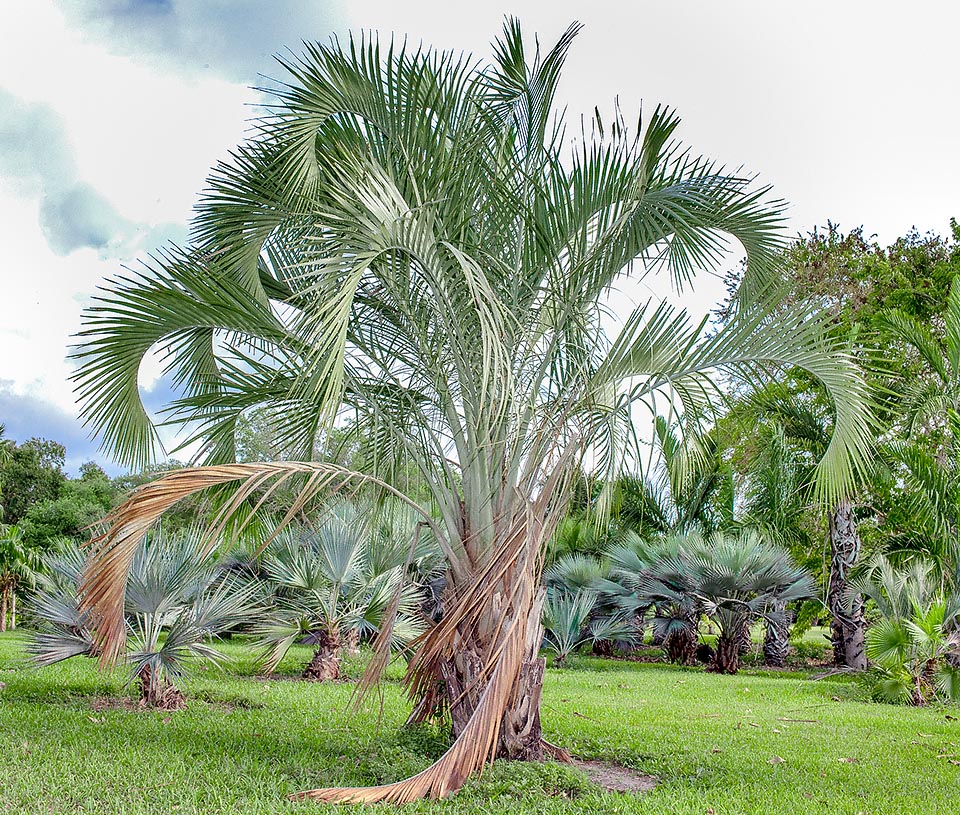Family : Arecaceae

Text © Pietro Puccio

English translation by Mario Beltramini
The species is native to the extreme south of Madagascar where it grows in the dry forest, on sandy and rocky soils, up to about 700 m of altitude.
The genus was dedicated to the German entrepreneur and partner Louis Frederic Jacques Ravené (1823-1879), descendant of a family of Huguenots that had taken refuge in Berlin on 1685; the name of the species is the combination of the Greek adjective “ξηρός” (xerós) = dry and of the substantive “φίλος” (philos) = friend, with obvious reference.
Common names: anivona palm (English); ahaza, anivo, anivona (Madagascar).
The Ravenea xerophila Jum. (1933) is a dioecious species, solitary, unarmed, with erect stem, up to about 8 m tall and of 30 cm of diameter that narrows when getting close to the top, thickly covered in the youngest part by the residues of the foliar bases, wrinkled and greyish in the oldest part. The rooting apparatus has a characteristic not met in other palms, besides the normal roots may be present tuberous roots, that is, roots with a marked lateral enlargement for part of their length, that might have function of reserve seen the particular environment where it lives. The leaves, on an up to 60 cm long petiole with quite sharp margins, are pinnate, arcuate, 1,6-2 m long, with about 50 pairs of rigid leaflets, linear-lanceolate with acuminate apex, in the median part 40-60 cm long and 1,5-2,5 cm broad, regularly arranged along the rachis to form a V facing upwards, coriaceous, of glaucous color. The foliar base, 40-50 cm long, open on the side opposite to the petiole, is covered by a brown tomentum below, by a white waxy patina above. Inflorescences between the leaves (interfoliar), the male ones, up to about 60 cm long, with ramifications of first order and solitary flowers with trilobed calyx, 3 petals merged at the base and 6 stamens.

Very decorative due to the elegantly arcuate ascending leaves, the Ravenea xerophila grows in arid zones at the extreme south of Madagascar where may reach the 8 m of height. At extinction risk in nature, due to the limited number of individuals and the habitat reduction, adapts to warm temperate climates only if the drainage is perfect © Giuseppe Mazza
Female inflorescences, up to 80 cm long, with ramifications of first order and solitary flowers with trilobed calyx, 3 free petals, 6 staminodes, ovoid gynaeceum and 3 stigmas. Globose fruits, of 2-2,5 cm of diameter, or bi- trilobed, yellow when ripe, containing 1-3 seeds.
It reproduces by seed, previously kept in water for 3 days, in draining loam kept humid at the temperature of 26-28 °C, with germination times starting from 1-3 months. Great care should be taken in the transplants because of the particularly delicate rooting apparatus.
Considered as one of the most characteristic palms of Madagascar due to the ascending leaves highly and elegantly arcuate of glaucous colour, it has been introduced with success in cultivation in some regions with tropical, subtropical and milder warm temperate climate characterized by a marked dry season, where it has proved a good resistance to the low temperatures bearing exceptional values up to about -5 °C in dry, with possible harm to the foliage. Its main requirement is a perfectly draining soil, it easily dies due to water stagnation especially if associated with low temperatures. Slow growing, needs a position in full sun and has proved adaptable to various types of soil, ideal for desert type gardens thanks to its resistance to the drought.
The leaves are utilized by to local populations for fabricating hats, bags, basket and other handicrafts.
Because of the limited number of individuals and the progressive reduction of its habitat, the species is inserted in the red list of the IUCN (International Union for the Conservation of Nature) as “vulnerable” (species risking the extinction in nature).
